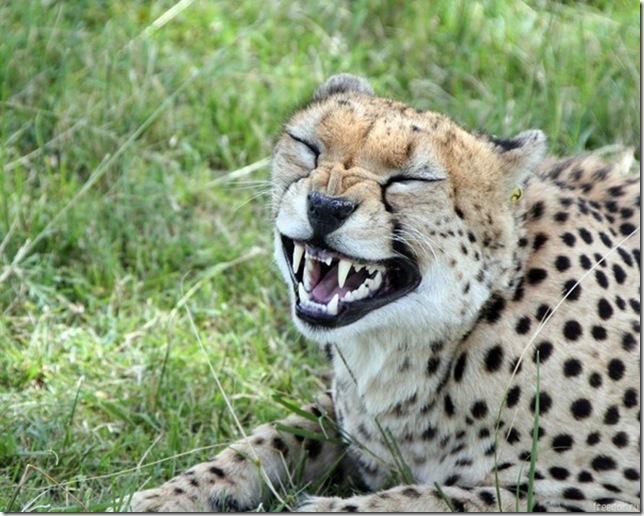The cheetah is the fastest animal on earth
This beast for some 2 seconds from a standstill can reach a speed of 65 km / h! And then run at a speed of 110 km / h! The cheetah is the fastest land mammal. A racehorse, for example, can run at just over 70 km/h, and a greyhound about 65 km/h. However, unlike them, the cheetah can develop such incredible speed only over short distances.
Cheetahs (Acinonyx: the generic name of a cheetah, whose scientific name and patronymic is Acinonyx jubatus.) are representatives of the cat family, although they also have many dog features. Sick, for example, canine diseases. Like dogs, they sit and hunt. The coat of cheetahs is similar to that of smooth-haired dogs. And blurry spots on the skin already resemble cat fur. On the ground, these animals leave completely cat-like footprints and, like cats, like to climb spreading trees (cheetah cubs climb better, because in adults, the claws are already blunter, because they do not retract for better grip on the ground. Claws on the forelimbs light, large, with sharp ends bent forward and upward. The claw of the first finger is especially large. With a long paw, armed with this claw, like a spearhead, the cheetah delivers such a strong blow that the overtaken victim flies somersaults. Cheetah babies can retract their claws like kittens, only up to 10 - 15 weeks, later the claws become almost motionless, and in accordance with which the pastern is more like a dog.In general, the construction of the body of a cheetah almost repeats the silhouette of a greyhound, and some moments in behavior are also more inherent in dogs.The muzzle of a cheetah is beautiful and very peculiar. Two black stripes stretch from the eyes to the corners of the mouth, giving the cheetah a sad and even unhappy look.The cheetah's coat is short, sandy in color, and all the skin - except for the light belly - is strewn with small dark spots. In newborn cubs, the coat is darker, and a thick ashy "mane" stretches along the back from the neck to the tail. The sounds made by the cheetah are similar to the abrupt chirping of a bird. They are heard at a distance of two kilometers and allow the cheetah to communicate with their cubs and relatives. The cheetah has a gentle and peaceful disposition. When a cheetah is happy, it purrs like a huge house cat. The cheetah very quickly gets used to the person, it can be tamed. An adult cheetah can weigh over 45 kg.

A cheetah is not born a hunter, but becomes, and only if his mother teaches him an "intensive training course." Captive-born cheetahs do not know how to sneak up on prey and chase the victim. Joint meals of mother and cubs are held very peacefully, without litter and fights. There are cases when in arid regions the cheetah ate juicy wild melons. Tourists who go on African safaris are very surprised that these peace-loving animals are not at all shy. An adult cheetah can come and lie down in the shade of a tourist van, or jump on the hood of a car and peer through the glass with curiosity at admiring, and sometimes seriously frightened people. Despite all the similarities with their feline relatives, scientists distinguish the cheetah for its originality into an independent genus, and some theriology even into a separate feline subfamily. So far, there is no consensus on the number of subspecies of the cheetah. Most zoologists agree on seven, some of this seven recognize only two - Asian venaticus and African jubatus, which are translated from Latin as "hunting" and "having a mane." In fact, this is not a mane, but a short mane, like a comb of slightly elongated hair.

A cheetah can really run like a whirlwind. Incredibly, this beast can reach a speed of 65 km / h in just 2 seconds from a standstill! And then run at a speed of 110 km / h! The cheetah is the fastest land mammal. A racehorse, for example, can run at just over 70 km/h, and a greyhound about 65 km/h. However, unlike them, the cheetah can develop such incredible speed only over short distances. The cheetah is an animal with a tucked-in body, long, slender legs and a flexible, arched back. The long spotted tail helps the cheetah to make sharp turns while running at full speed. At its highest speed, the cheetah can run up to 6 meters in leaps. The unique legs help the cheetah develop such exceptional speed, which are more similar in structure to the legs of a dog than a cat. And the claws help the cheetah not to lose stability while running.
Cheetah sets new 100m animal world record

A female cheetah has set a new world record for the 100m animal race in the United States, running the distance in 6.13 seconds. As reported on Friday, September 11, 2009, on the website of the British newspaper Evening Standard, the race was held at the zoo in the US city of Cincinnati. Sarah, an eight-year-old female cheetah, broke the previous world record set in 2001 by a South African cheetah. According to the organizer of the race, Sarah used three attempts to set the record. To keep the cheetah from going astray, the zoo staff used a lure similar to that used at dog races. Note that the cheetah ran a hundred meters three seconds faster than the best runner among people - a native of Jamaica, Usain Bolt. His time at this distance was 9.58 seconds.


The elegant swift cheetah is a cat that doesn't look like a cat at all. He is the fastest runner on earth and, chasing prey, is able to run at speeds of up to one hundred kilometers per hour for some time. He does not know how to roar like big cats, but only yelps like a dog or emits an amazing, completely bird-like chirp. Three months after mating, a female cheetah gives birth to two to four spotted kittens. The African cheetah is born with a mane on its head and back, as light as a gray streak of mist, but over time it changes, becoming short and stiff. Tear streaks stretch from his eyes to his upper jaw, curving like the horns of a lyre, and give the cheetah a sad expression. At the age of three to four months, young cheetahs already follow their mother during the predawn and evening hunts and learn to sneak up on prey, freeze if the intended victim suddenly becomes alert, get up again and so on until there are a hundred meters left to the herd, and then reddish - yellow lightning to rush forward. Although cheetah cubs, like all kittens, are born with claws as sharp as pins, these claws hardly retract, and become dull with age and no longer serve as a weapon and do not help climb trees. Adult cheetahs climb very poorly and climb trees only if they have nowhere else to hide from larger predators. The teeth and jaws of the cheetah are not as powerful and formidable as those of lions and tigers, and the muzzle is more like a dog than a cat. Therefore, young cheetahs should take over from their mother the throw exactly on the victim's throat. A bite in another place will not knock her down and the blows of deadly hooves and horns will fall on the predator. Standing still, the spotted cheetah looks rather awkward - arched back, wasp waist, thin legs. But as soon as he starts running, in 2 seconds a speed of 70 kilometers per hour is developed, how to become the embodiment of graceful swiftness. Non-retractable claws transform into record runner spikes and allow the cheetah to turn and change direction in the blink of an eye. Rushing alongside a herd of frightened Thomson's gazelles - his favorite prey - he knocks down his intended victim on the run, then jumps and kills him with one bite to the throat. Unlike big cats, the cheetah does not eat carrion. Having eaten his fill of freshly killed prey, he leaves the carcass to the vultures and jackals. Sometimes cheetahs hunt in pairs or family groups, but they do not belong to social animals. What may seem like a pride in a cheetah is in fact most often a female with grown cubs that will leave her when they reach the age of two. Despite its hunting skill, the cheetah is by nature an affectionate, calm animal, and not a single case is known of him attacking a person. People in relation to him were not so peaceful.


King cheetah - Acinonyx jubatus. In 1981, at the DeWildt Cheetah Center (South Africa), a new cheetah mutation called the king was noted. Cheetahs with this coloration are extremely rare in nature. That year, the king cheetah was born in captivity for the first time. In terms of body structure, it is no different from an ordinary cheetah, but its coloration contains especially large marks, and all the spots are connected in a pattern. The first king cheetah was discovered in 1926 in Zimbabwe and was initially mistaken for a new variety of cheetah. Only 50 years later, in 1974, the first photograph was taken (Kruger National Park). At first it was thought that it was a hybrid of a cheetah and a leopard, but genetic tests disproved this theory. King cheetahs can interbreed with ordinary cheetahs, resulting in a full-fledged offspring. A royal-colored cub can be born from normal-colored parents. In the diet of cheetahs, the main place is occupied by small prey - Grant's and Thompson's gazelles, impala antelopes, hares and birds. They eat only that part of the prey that they can eat at one time and do not return to the remains of the carcass, because they are not able to defend it. He is fast but not strong.








